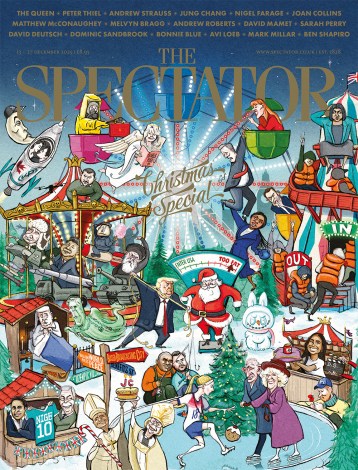What did St George do? Killed a dragon, as everyone knows. And yet, as Samantha Riches points out, no mention of the dragon is made before the Norman Conquest. Nor is the pairing ‘England and St George’, invoked by Shakespeare’s Henry V, much noted outside Britain. Foreigners do not know that the English think St George is theirs alone. Many other nations are keen on him — Ethiopia, with a 13th-century church carved out of rock for him, Egypt where the Copts rejoice in him, or of course Georgia — and they all tell local versions of his legend.
One quite untrue tale is Edward Gibbon’s identification of him, which Riches soon dismisses, as a Cappadocian salesman of questionable pork to the Roman army who rose to be archbishop of Alexandria and was murdered in AD 362 by an angry mob because of his heretical Arianism. Gibbon’s version, which can hardly have been quite honestly made, was forcefully refuted, Riches notes, by Dr Samuel Pegge in a paper to the Society of Antiquaries in 1777. Yet it still gets trotted out, partly because Ralph Waldo Emerson, without the slightest effort to check, retailed it in English Traits.
George was said to have been martyred in AD 303, and, we learn, there are mid-fourth-century Syrian church inscriptions marking devotion to him. Perhaps it is because nothing was known of his life apart from his martyrdom that he has attracted such varied legends. Riches has spent more than two decades studying them, and happily considers the most unlikely connections. This is where, I think, we run into a spot of trouble.
One of St George’s analogues — as the folklorists like to call such lookalikes — is a figure in Islamic cultures called al-Khidr, a name sometimes translated as the Green One. He is associated with a fountain of youth, with regeneration and healing. Palestinian Muslims recognise the Christian representation of St George at Beit Jala, for example, as al-Khidr. But I can’t help feeling that thrusting on to St George the traditions of al-Khidr is an example of analogue greed.
Riches herself gives a very funny example of such greed in the context of Cornish folklore. At Padstow, on the north Cornish coast, there is a song for May Day that has been claimed to reinforce St George’s associations with water:
O where is St George, where is he O?
He’s in his longboat
All on the salt sea O!
You can picture the folklorists scratching their beards with eager attention. But the rest of the stanza is a sore disappointment to St Georgists:
Up flies the kite and down tails the lark O,
Aunt Ursula Birdwood she had an old ewe,
And she died in her own park, O!
As Riches sagely remarks:
It is difficult to state with any confidence that these lines relate to the legend of St George. It seems about as likely as the contention — which is based on a report from Brazil — that St George returned to English shores after making a trip to South America with his wife Joan of Arc.
It might then be wise to apply the same scepticism to the al-Khidr connection. Stranger legends, it’s true, have been thrust on to saints: I’m always amused to recall that the story of Saints Balaam and Josaphat derives circuitously from a life of the Buddha. The complicating factor with al-Khidr, by contrast, is his appearance in the Quran. His name is not used there, but the story that Riches tells is straight from Surah 18. It is a baffling tripartite tale of Moses learning from the peculiar behaviour of a servant of God (identified in tradition as al-Khidr). One of the three incidents is of al-Khidr killing a boy. Later it is explained that ‘the boy was intending to rebel against his God-fearing parents’, as Riches expounds the verses, ‘and they would be given a better son in exchange.’ So that’s all right, then.
Another symptom of analogue-greedy Georgists wanting to recruit al-Khidr is an interpretation of a mysterious sketch of a stained-glass window in Stamford, Lincolnshire, since destroyed. The sketch was made for good old William Dugdale, the 17th-century antiquary. The trouble is that he did not explain it in his accompanying uncompleted manuscript on St George, nor is it clear what it depicts. It shows a halo’d figure with sword uplifted beside a well, where a woman lies with a jug spilt on the ground. This might fit in with notions of al-Khidr’s watery connections, but not with surviving versions of St George’s story from 17th-century England.
Every page of this crammed chrestomathy of Georgiana had me entertained or bursting to disagree. Samantha Riches falls into academese only when she argues that
England is now, and has been for many centuries, a diverse country with an array of cultures, ethnicities, sexualities, genders and belief systems. St George is able to encompass all these multiplicities.
Yet, partly because Protestant dogma forbade festivities in honour of such saints, England has fallen into indifference about George, leaving his flag and name at the mercy of nasty nationalists. I’d be happy enough with the legend as told in the Golden Legend, as edited by Caxton (not mentioned here). He’s the saint honoured at St George’s, Windsor, home to the Order of the Garter, the insignia of which, of course, includes a dragon.
Available from the Spectator Bookshop, £13.95 Tel: 08430 600033






Comments